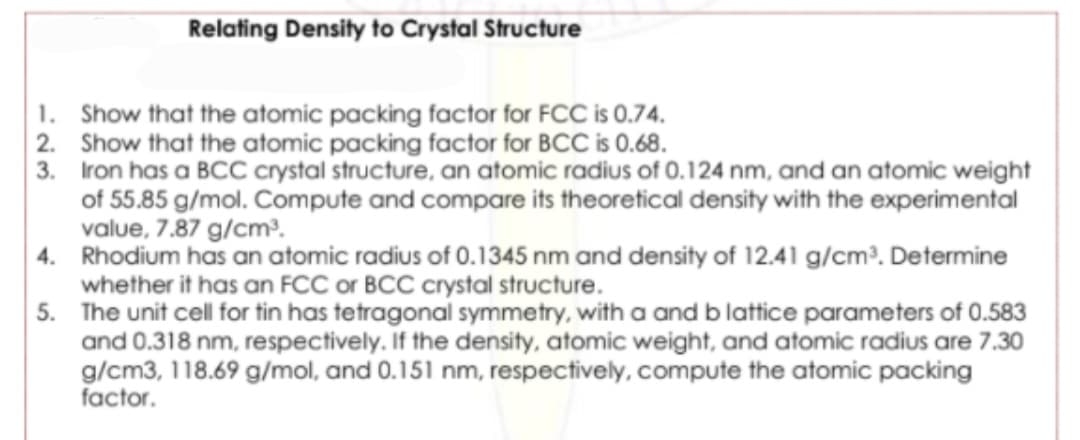3. Iron has a BCC crystal structure, an atomic radius of 0.124 nm, and an atomic weight of 55.85 g/mol. Compute and compare its theoretical density with the experimental value, 7.87 g/cm³. 4. Rhodium has an atomic radius of 0.1345 nm and density of 12.41 g/cm?. Determine whether it has an FCC or BCC crystal structure. Th nd b lattio of O 592
3. Iron has a BCC crystal structure, an atomic radius of 0.124 nm, and an atomic weight of 55.85 g/mol. Compute and compare its theoretical density with the experimental value, 7.87 g/cm³. 4. Rhodium has an atomic radius of 0.1345 nm and density of 12.41 g/cm?. Determine whether it has an FCC or BCC crystal structure. Th nd b lattio of O 592
Chemistry by OpenStax (2015-05-04)
1st Edition
ISBN:9781938168390
Author:Klaus Theopold, Richard H Langley, Paul Flowers, William R. Robinson, Mark Blaser
Publisher:Klaus Theopold, Richard H Langley, Paul Flowers, William R. Robinson, Mark Blaser
Chapter10: Liquids And Solids
Section: Chapter Questions
Problem 88E: A compound of cadmium, tin, and phosphorus is used in the fabrication of some semiconductors. It...
Related questions
Question
Answer 3

Transcribed Image Text:Relating Density to Crystal Structure
1. Show that the atomic packing factor for FCC is 0.74.
2. Show that the atomic packing factor for BCC is 0.68.
3. Iron has a BCC crystal structure, an atomic radius of 0.124 nm, and an atomic weight
of 55.85 g/mol. Compute and compare its theoretical density with the experimental
value, 7.87 g/cm³.
4. Rhodium has an atomic radius of 0.1345 nm and density of 12.41 g/cm³. Determine
whether it has an FCC or BCC crystal structure.
5. The unit cell for tin has tetragonal symmetry, with a and b lattice parameters of 0.583
and 0.318 nm, respectively. If the density, atomic weight, and atomic radius are 7.30
g/cm3, 118.69 g/mol, and 0.151 nm, respectively, compute the atomic packing
factor.
Expert Solution
This question has been solved!
Explore an expertly crafted, step-by-step solution for a thorough understanding of key concepts.
This is a popular solution!
Trending now
This is a popular solution!
Step by step
Solved in 2 steps with 2 images

Knowledge Booster
Learn more about
Need a deep-dive on the concept behind this application? Look no further. Learn more about this topic, chemistry and related others by exploring similar questions and additional content below.Recommended textbooks for you

Chemistry by OpenStax (2015-05-04)
Chemistry
ISBN:
9781938168390
Author:
Klaus Theopold, Richard H Langley, Paul Flowers, William R. Robinson, Mark Blaser
Publisher:
OpenStax

Principles of Modern Chemistry
Chemistry
ISBN:
9781305079113
Author:
David W. Oxtoby, H. Pat Gillis, Laurie J. Butler
Publisher:
Cengage Learning

Physical Chemistry
Chemistry
ISBN:
9781133958437
Author:
Ball, David W. (david Warren), BAER, Tomas
Publisher:
Wadsworth Cengage Learning,

Chemistry by OpenStax (2015-05-04)
Chemistry
ISBN:
9781938168390
Author:
Klaus Theopold, Richard H Langley, Paul Flowers, William R. Robinson, Mark Blaser
Publisher:
OpenStax

Principles of Modern Chemistry
Chemistry
ISBN:
9781305079113
Author:
David W. Oxtoby, H. Pat Gillis, Laurie J. Butler
Publisher:
Cengage Learning

Physical Chemistry
Chemistry
ISBN:
9781133958437
Author:
Ball, David W. (david Warren), BAER, Tomas
Publisher:
Wadsworth Cengage Learning,

Chemistry & Chemical Reactivity
Chemistry
ISBN:
9781337399074
Author:
John C. Kotz, Paul M. Treichel, John Townsend, David Treichel
Publisher:
Cengage Learning

Chemistry & Chemical Reactivity
Chemistry
ISBN:
9781133949640
Author:
John C. Kotz, Paul M. Treichel, John Townsend, David Treichel
Publisher:
Cengage Learning

Chemistry for Engineering Students
Chemistry
ISBN:
9781337398909
Author:
Lawrence S. Brown, Tom Holme
Publisher:
Cengage Learning